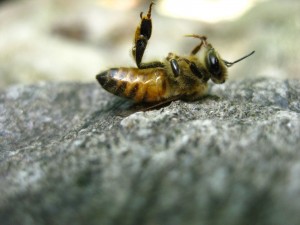News headlines of late are sounding a disturbing alarm. Where have all the Bees Gone?
The culprits range from weather to pesticides but no one really seems to know why. What we do know is that if the bees are to be wiped out we’d take a 14 billion dollar hit on farmers crops. Honeybees don’t just make honey; they pollinate more than 90 of the tastiest flowering crops we have.Among them: apples, nuts, avocados, soybeans, asparagus, broccoli, celery, squash and cucumbers. And lots of the really sweet and tart stuff, too, including citrus fruit, peaches, kiwi, cherries, blueberries, cranberries, strawberries, cantaloupe and other melons.The scramble to figure out what to do next in order to insure nations and worlds food supply is in full gear.
Apparently this same thing happened back in the early 90’s and the bees were being killed by a parasite. Bees do not have great resistances in their gene make up and their gregarious nature helps problems like these spread.
The most likely scenarios seem to be a combination of weather extremes reported widely of bee  researchers in Maryland to a parasite found throughout the world that now seems to have spread to Canada.The parasite is common in Asian bees and has spread to Europe and the Americas. The microscopic parasite is called ‘nosema ceranae’. Scientists have examined thousands of samples from stricken hives in many countries. The beginning premise was that it was pesticides causing the problems with the bees. Soon this was ruled out in that only small traces in a tiny percentage of the bees sampled had any lethal doses. Also some bee hives were dying miles away from any cultivated lands which would have no known exposure to pest control products. The spores of a parasite called ‘nosema apis’ were present in most samples but that certain parasite would only be active in wet weather and these bees were dying in dry as well as wet conditions. At that time it was decided to do a DNA test and it was found that ‘ceranae’ which is a deviant of ‘apis’ was found. This parasite can live in cold,wet and dry weather and a hive can be infected in 2 months and the hive will die in a couple of days thereafter. Although test have not as yet been done in American bee hives it is certain that this parasite is a main culprit of the worlds bee elimination.
researchers in Maryland to a parasite found throughout the world that now seems to have spread to Canada.The parasite is common in Asian bees and has spread to Europe and the Americas. The microscopic parasite is called ‘nosema ceranae’. Scientists have examined thousands of samples from stricken hives in many countries. The beginning premise was that it was pesticides causing the problems with the bees. Soon this was ruled out in that only small traces in a tiny percentage of the bees sampled had any lethal doses. Also some bee hives were dying miles away from any cultivated lands which would have no known exposure to pest control products. The spores of a parasite called ‘nosema apis’ were present in most samples but that certain parasite would only be active in wet weather and these bees were dying in dry as well as wet conditions. At that time it was decided to do a DNA test and it was found that ‘ceranae’ which is a deviant of ‘apis’ was found. This parasite can live in cold,wet and dry weather and a hive can be infected in 2 months and the hive will die in a couple of days thereafter. Although test have not as yet been done in American bee hives it is certain that this parasite is a main culprit of the worlds bee elimination.
Treatment for ‘nosema ceranae’ is effective and cheap but what remains an obstacle is bee keepers resistance to recognize this problem and it’s solution. It seems the blame is more on the side of weather conditions and mans pesticide applications which at the very least is lowering the bees resistance. Either way we need to solve this dilema so we can continue to enjoy the benefits one of natures perfect insects. Bees.





